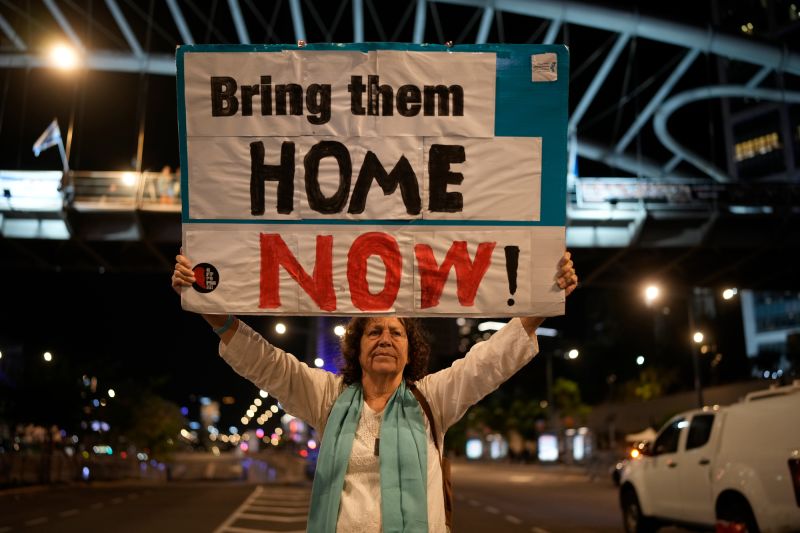
Israel-Hamas truce believed to be holding, with hostage release expected in coming hours
A truce between Israel and Hamas that was scheduled to begin at 7 a.m. local time (12 a.m. ET) Friday is believed to be holding, with civilian hostages held captive by militants expected to be released in the coming hours as part of a breakthrough diplomatic deal following an uneasy day-long delay.
The pause in fighting, part of the carefully negotiated agreement announced Wednesday, appeared to be taking effect despite what sounded like sporadic Israeli artillery fire and sirens warning of rockets from Gaza in the minutes after it was due to begin.
They heard what sounded like small arms fire inside Gaza about 20 minutes later, but artillery fire, airstrikes and rockets appear to have stopped.
Two hundred trucks “loaded with food, medicine and water,” as well as others transporting fuel would cross into the Gaza Strip each day starting Friday, Diaa Rashwan, the chairman of Egypt’s State Information Service said that morning.
Sixty-seven Palestinians who got stuck in Egypt during the war traveled back into Gaza via the Rafah border crossing on Friday, hours after the truce went into effect. More Palestinians will be allowed to cross into the Strip starting Saturday if they wish to do so, the Palestinian embassy in Cairo said.
The first hostage release from Gaza is scheduled to take place later Friday, when 13 women and children held captive in Gaza are expected to be freed, mediators in Qatar said the previous day. Thirty-nine Palestinian prisoners would also be released by Israel Friday as part of the deal, according to an Israeli official.
The Israel Defense Forces (IDF) said it has completed preparations for receiving hostages released from Gaza back into Israel, including readying several locations with medical provisions and support for their initial reception.
The implementation of the four-day truce would mark the first sustained break in hostilities after nearly seven weeks of conflict – and the first expected large-scale release of hostages.
The agreement followed mounting pressure on the Israeli government from the families of the hostages, who have demanded answers and action from Prime Minister Benjamin Netanyahu.
It also comes amid growing international pressure for more humanitarian support for the people of Gaza, where the number of people killed since October 7 now stands at 14,854, according to information from Hamas authorities in the Strip.
Israel declared war on Hamas following the militant group’s bloody October 7 terror attack on its territory, in which more than 1,200 people were killed – the largest such attack on Israel since the country’s founding in 1948.
Militants are holding more than 200 people captive inside Gaza from mass abductions that day, according to figures from the Israeli military.
The IDF said Friday that they destroyed a number of tunnels underneath the Al-Shifa Hospital area in Gaza City they believe are used by Hamas and completed “operational preparations” according to the agreed truce, ahead of its anticipated start.
Israel’s defense minister said he expects the military operation against Hamas will continue “forcefully” after the truce.
Expected hostage release
Under terms previously announced by Qatar, a total of 50 of those hostages, women and children, are expected to be freed over a four-day humanitarian pause in fighting.
The first batch of hostages is expected to be released from Gaza at around 4 p.m. local time Friday and handed to the International Committee of the Red Cross, Qatar Foreign Ministry spokesperson Majid Al-Ansari said Thursday ahead of the pause.
Israel’s Ministry of Welfare and Social Affairs has released detailed instructions on how to care for released hostages who are children, advising IDF troops on how to interact with them in the moments following their release.
“Children will ask questions such as, ‘Where’s Mum? Where’s Daddy?’ Soldiers should not answer these questions, even if they know the answers. Any questions should be answered along the lines of, ‘Sweetheart, I’m sorry, I don’t know. My job is to bring you to Israel to a safe place, where people you know will be waiting for you and will answer all your questions,’” the advice says.
The deal also includes the further release of 150 prisoners during the four-day period, according to Israel. There is also the potential for an extension and more releases in the days following the currently agreed pause. Most of the prisoners concerned are male teenagers, along with some women, according to an Israeli government list of those who could be released.
The total number of Palestinian prisoners held in Israeli jails is approximately 8,300, according to Qadura Fares, the head of the Palestinian Prisoners Club, a non-governmental organization.
Of those, more than 3,000 are being held in what Israel calls “administrative detention,” which Amnesty International says can be extended indefinitely.
Humanitarian aid
The truce has been seen as an opportunity to ramp up humanitarian support to Gaza, though Qatari foreign ministry spokesperson Al-Ansari on Thursday warned “it would be a fraction of the need.”
The enclave has been struggling with severe shortages of basic supplies, food and fuel amid power outages and bombardment, with humanitarian groups and governments saying the levels of aid allowed in in past weeks were insufficient.
Israel has been highly reluctant to allow fuel into Gaza since October 7, citing concerns Hamas will use it to power its operations, even as aid groups say it’s critical for cooking food and maintaining operations at hospitals. Last week it agreed to allow minimal deliveries.
Israel’s Coordinator of Government Activities in the Territories, said in a statement Friday that four fuel tankers and four tankers of cooking gas crossed into Gaza through the Rafah Crossing.
“The fuel and cooking gas are designated for operating essential humanitarian infrastructure in Gaza” and was approved by the Israeli government as part of the truce, the statement said.
